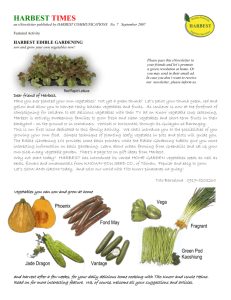bibweg health development organisation
advertisement
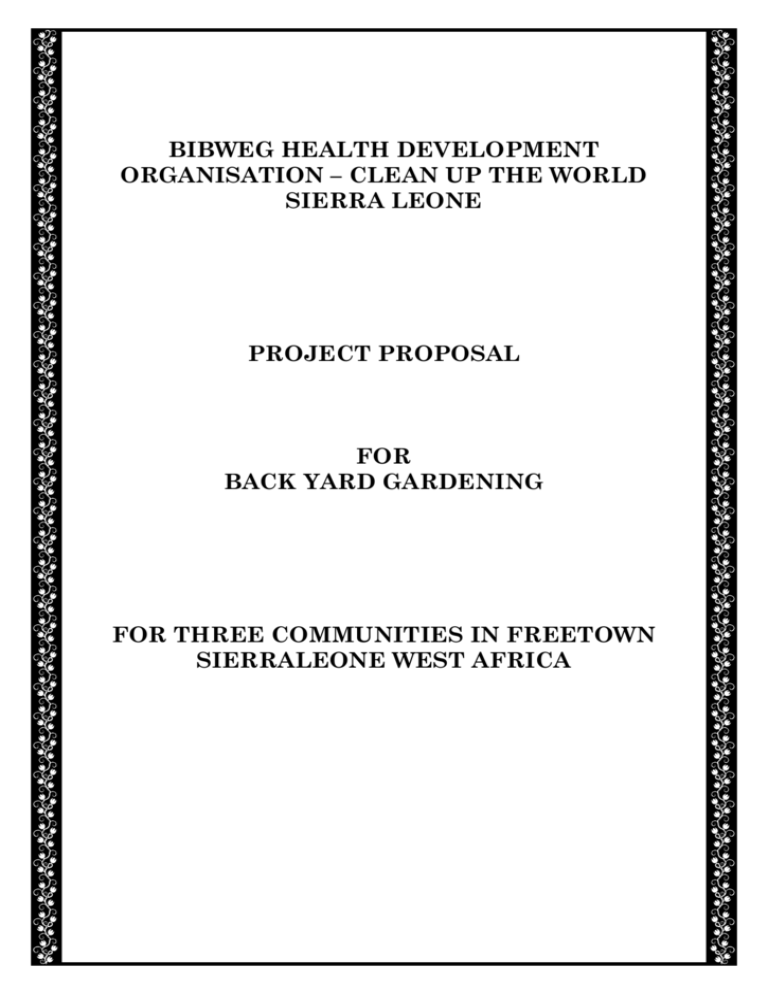
BIBWEG HEALTH DEVELOPMENT ORGANISATION – CLEAN UP THE WORLD SIERRA LEONE PROJECT PROPOSAL FOR BACK YARD GARDENING FOR THREE COMMUNITIES IN FREETOWN SIERRALEONE WEST AFRICA TITLE PAGE 1.1 Name of Project: Back Yard Gardening 1.2 Project Location: Glouster, Liecester Road and Sumaila Town Community Freetown 1.3 Project Sector: Agriculture 1.4 Project Implementors: BIGWEG Health Development Organisation/Clean Up World Sierra Leone 1.5 Project Duration: March 2008 – February 2009 (12 Months) 1.6 Targeted Beneficiaries: 150 Women 1.7 Fund Requested in Leones: Le 57,680,000 = $19,552,542 1.8 Community Contribution: Le 5,500,000 = $1,694.91 1.9 Total Project Cost: Le 63,180,000 $21,416.949 1.10 Contact Person: Dr. Yaw Benjamin – Founder And Executive Director 2.1 Address: CSE Compound PWD Quarter Freetown Sierra Leone West Africa 2.2 Contact Number: 232-33-770-726 / 26-2327738516 2.3 Email: tukaduwinneba001@yahoo.com 3.1 BACKGROUND INFORMATION/PROBLEM ANAYSES Glouster, Leicester and Sumiala Town are found in the Western urban within the Freetown municipality. It has a population of about five hundred and sixty two thousand people and 60% of their activities are predominantly back yard gardening and it basically done by women on which they heavily depend upon, to augment their basic livelihood. These activities were interrupted during the war but have now started with a high interest. 35% depend on the production of cash crops, and few other mixes cropping which they use to complement the affairs of their children and the home. The idea of forming this project was born out of the subsistence farming which they had engaged on for over the years which does not help alleviate them from their poverty. The projects is a community based agricultural development endeavour, designed and planned to facilitate the resettlement and socio-economic empowerment of indigenous of the said community Women. Bibweg Development Organisation Sierra Leone realized the need for this people to be assisted in the production of more vegetables gardening for commercial purposed for sustainable living. The women are too poor to provide themselves with the basic farming input, seeds and chemicals for the speedy production of vegetables. Bibweg Development Organisation Sierra Leone realized the need for these people to improve their back yard gardening if only assisted by engaging them consistently since women play a vital role in promoting the welfare of their families. As a result of a survey conducted by our organization, we realized that the following problems were identified as follows: The group is too poor to provide for themselves with the basic gardening inputs such as seeds, tools and chemical fertilizers. They do not have the technical support that will help in the smooth running of an improved gardening system. Food for work during group work is important because it extends the time of working and facilitate full participation of the general membership. Food aid can be use as cost effective investment tool for supporting back yard gardening This proposal has been developed within the context of rural development and poverty alleviation in the communities mentioned. This concept is based on the recognition that after the war, although immediate humanitarian needs have been addressed, immediate resettlement and hence the need for the support of back yard gardening should be viewed as laying the foundation for sustainable economic growth and development of these women. 3.2 JUSTIFICATION Sierra Leone, which has a population of about 4.9 million, occupies a very prominent place among the countries listed as least developed in the world. Despite this, it is endowed with a rich natural resource base and favourable climatic and environmental conditions conducive to productive agriculture. This fact is underlined by the country’s distinct seasons – dry season (December to April) and west season (May to November. The annual rainfall ranges from 2,030mm in the North-East to 5,350mm in the Coast. Day temperature are usually highest (340 – 360) in March and lowest (250 - 280) in January, July and August. Land use estimates done by FAO show far less than a fifth of the total arable land being utilized for crop production, a phenomenon party responsible for the country’s chronic deficit in terms of agricultural productivity. Trends in the production of vital food crops (tree crops, vegetables, cereals and tubers) in selected areas before the ten year long rebel war in terms of both the area cultivated as well as average yields were not encouraging. Considering the mass exodus of the rural farming population to urban areas as a result of the war, the postwar level of production of these crops will be even more depressing. Less than 20% of the country’s arable land has been utilized including even the fertile lowlands which bear the greatest potential for sustainable agriculture by virtue of their favourable year round water regime status. Several factors have been responsible for this downward trend in agricultural productivity. Some of these are: Inaccessibility of improved, high yielding planting material (for especially tree crops and vegetables) being a direct consequence of the lack of vital and sustainable nurseries. Little or no facilities no basic inputs like seeds, tools, chemicals and other materials. Lack of technical know-how no modern crop production to include pest and disease control. In the past, these women have indeed expressed interest in vegetable gardening production but they lack the necessary capital to procure seedlings of improved, high yielding varies. Where these are available, they are usually either too expensive or of unimproved grade. The situation was further worsened by the absence of credit/loan facilities. Most improved varieties of agricultural crops are usually accompanied with certain agronomic packages, which must be simultaneously implemented alongside their adoption if the full yielding potential of these crops is to be realized. Farmers therefore need to be trained on the significance of the incorporation of these agronomic packages on overall production. Supporting these women will help salvage the problems they face as out lined above. They will also use it as a strong tool for self-sustenance to maintain gender equity. 3.3 SHORT TERM AIMS AND OBJECTIVES To inject a spirit of self-livelihood improvement in interested farm through their active participation in the agricultural sector. To train interested women on modern agronomic practices involved in vegetable crop, cereal, and tuber production on a sustainable basis. Provide employment in the agricultural sector for the ever-increasing number of community women with the overall aim of making them self-reliance. Engage especially women in sustainable vegetable production in consonance with national gender expectations. This is expected to increase their productivity and reduce dependency on men. To provide opportunities for poverty all alleviation and to increased food crop production through empowering women in the agricultural sector. 3.4 LONG TERM AIMS AND OBJECTIVE To improve the income generating opportunities for the community women in general. To enable the rural community women to improve their standard of living and quality of life including their children. Increase the rate of vegetable production with member groups to resuscitate individual membership and provide the source of income for women. Create mutual understanding with in women for awareness raising in the field of vegetable gardening in building a work force. To provide an opportunity for poverty alleviation and increase vegetable production. To develop a market-oriented economy in the community through agro based activities. To complement government effort in the re-settlement of farm families affected by the decade long war. SPECIFIC OBJECTIVES To undertake vegetable gardening to enable women with their community to solve major financial problem from the sale of the produce. To mobilize and sensitized the beneficiaries for long term effect change and popular participation in the activities of the project. To empower women through the input provided, which they will use for sustained. Undertake training on the use of improved vegetable seedlings, application of fertilizers and the use of insecticide in the back yard garden for disease control. 3.5 IMPLEMENTATION STRATEGY The project implementation strategies are based on the growth of the community and community welfare responsiveness. Vegetable gardening in the predominant economic activity within these villages and employs 65% of the population of women but this requires a cost effective organizational structure of the project that is adequately flexible to reach the grass roots. Successful implementation of this programme would require: Safe and secured investment environment to attract offshore capitalization or door contribution and sustainable agriculture. Government on its part must be faithful and sincere, to enable the private sector to play its proper role in agricultural development and productivity. This women have been grouped into three communities and this communities will be supplied with the seeds acquired to enable each woman have access to a share. Each group have a committee that is responsible to coordinate the implementation process. The project coordinators together with these committees will supervise and monitor the implementation of the project. Purchasing of seeds and tools will be done in joint effort with the set committees. The project coordinator will do all report writing on activities and financial update. The implementing organization will play an over-all Management, Coordinating and supervision roles in the planning, designing and implementation of the project in collaboration with the beneficiary communities. They will continue to identify and register women groups operating within these communities. The organization believes in the concept of co-operate producer arrangement. This will collaborate with women who will provide direct management of the programme. And will device the relevant credit sales arrangement for women. Input sales or distribution arrangement and tools and implement sales. This direct relationship with the women groups will create a formidable commercial constituency for a viable and profitable commercial venture for investment that will generate a decent cash flow and will enable the recovery of any investment. To enhance accountability and transparency, the project is organized and will be managed along the project beneficiaries. Each group will be responsible for clearing and digging of their gardens, and will be responsible to provide land for the implementation of the project, these will trained on new methods on the use of inputs required. 3.6 EXPECTED PROJECT ACTIVITY Meeting with groups to discuss the implementation of the programme Identification and clearing of sites Supplying tools and seeds Supervising garden work Harvesting and marketing of produce Monitoring and evaluation of progress Monthly spear writing to door on development 3.7 MONITORING AND EVALUATION The project will collaborate with the line Ministry of Agriculture, and food security in the areas of personnel training assignment and extension services covering all technical areas of vegetable crop production. Project monitoring and evaluation are as continuous as the continuity of the project it self, hence the creation of firm community base management structure through which the project will be implemented monitor and evaluation the fulfillment of the project objectives. Sample reporting forms will be used by the M. & e. officers, from which he will submit a written report on quarterly bases to donors. 3.8 SUSTAINABILITY Based on the cost recovery these women will be given this seeds to continue every year, and there is going to be a set group to monitor the recovery each harvest season. That is each woman will pay back the number of seeds given to you, and this seeds will be given to other women, groups in other communities as the organization is also looking to extend this opportunity to other areas. 3.9 BUDGET LINE FOR VEGETABLE SEEDS, TOOLS AND CHEMICALS FOR ONE COMMUNITY DESCRIPTION QTY. UNIT COST Hot Pepper 100 tins 10,000 Egg Plants 150 tins 10,000 Okra 100 tine 5,000 Spring Onion 100 tine 15,000 Bold Onion 50 tins 10,000 Tomatoes 100 tine 10,000 Maize 100 plst. 5,000 Cabbage 50 pks 5,000 Lettuces 50 pks 5,000 Green 50 pks 5,000 Garden Eggs 100 tins 10,000 Water Melon 50 tins 15,000 Chemical fertilizer Npk 15, 15 50 bags 100,000 SUB-TOTAL TOTAL COST 1,000,000 1,500,000 500,000 1,500,000 500,000 1,000,000 500,000 250,000 250,000 250,000 1,000,000 750,000 5,000,000 DONOR CONTR. 1,000,000 1,500,000 500,000 1,500,000 500,000 1,000,000 500,000 250,000 250,000 250,000 1,000,000 750,000 5,000,000 14,000,000 COMMU. CONTRI. - Total budget for one community = Le 14,000,000 x 3 communities = Le 42,000,000 4.1 BUDGET FOR INPUT REQUIREMENT FOR TOOLS DESCRIPTION Hoes Bigs Cutlasses Small Hoes Shovels Pruning Saw Rakes Watering Can Hand Fork Spade Measuring Tape Transportation Labour Land Lease SUB-TOTAL 4.2 QTY. 150 150 150 150 150 150 150 150 150 6 6 Acres UNIT COST 10,000 10,000 5,000 15,000 10,000 10,000 15,000 5,000 10,000 30,000 Lump sum Lump sum 500,000 TOTAL COST 1,500,000 1,500,000 750,000 2,250,000 1,500,000 1,500,000 2,250,000 750,000 1,500,000 180,000 DONOR CONTR. 1,500,000 1,500,000 750,000 2,250,000 1,500,000 1,500,000 2,250,000 750,000 1,500,000 180,000 2,000,000 2,000,000 1,500,000 15,680,000 COMMU. CONTRI. 2,000,000 3,500,000 5,500,000 BUDGET SUMMARY Vegetables: Tools/Chemical fertilizers/Transportation: Donor Grand/Total: Community/Ips Contributions: Le 42,000,000 Le 15,680,000 Le 57,680,000 Le 5,500,000 PROJECT GRAND TOTAL 1. Donor Contribution: 2. Community/Ips: G/TOTAL: LE 63,180,000 Le 57,680,000 Le 5,500,000
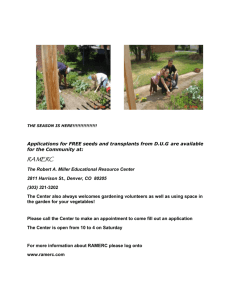


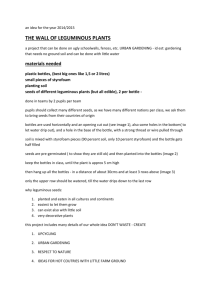

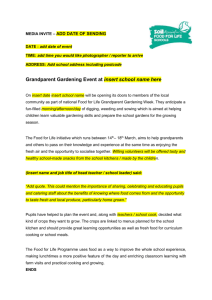
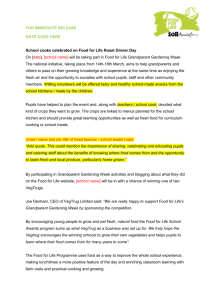
![Newsletter 26.04.13[1]](http://s3.studylib.net/store/data/006782410_1-da9f3895022a2272f47db633b66536f9-300x300.png)
